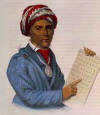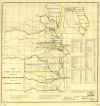| AIS 100: Introduction to American Indian Studies |
Cherokee
The Cherokee originally occupied parts of Tennessee, North Carolina, South Carolina and Georgia centering on the Blue Ridge Mountains and Great Smoky Mountain NP. They numbered in the range of 30,000-40,000 in traditional times and lived in large farming (CBS) villages. Many Cherokee were forcibly removed in 1838 to Oklahoma to form the Western Cherokee. Some Cherokee eluded capture in the mountains. Eventually some of these Eastern bands got recognition in North Carolina and are known today as the Eastern Cherokee. Others Cherokee groups West and East in Arkansas, Texas, South Carolina and Georgia did not receive official recognition but have organized into dintinct culture groups.
I. Origins
The Cherokee are Southern Iroquoian language speakers and
therefore were at one time connected to the Iroquois people of the Northeast and
may have broken away ~3,800 years ago. The Cherokee and the Iroquois maybe
derived from ancient Woodland cultures of the Ohio River Valley region and
drifted moved Northeast and Southeast respectively. It
is certain that DeSoto 1539 contacted Cherokee and probably through disease
caused disruption of Cherokee towns extending into Georgia's Savannah River
country. Thus, the traditional Cherokee were reduced in size and had moved
somewhat north by the 18th century.  Traditional
Stick-Ball
Traditional
Stick-Ball
II. Traditional Culture
The pre-contact population was over 30,000 and by the early 1700s Cherokee population was about 16,000 in over 60 villages. The Cherokee were pretty much living traditional lifestyle into the mid 1700s.
| Cherokee | <1750 |
II. Contemporary
The Cherokee were part of a group of Southeastern groups
that changed their traditional cultures to be more like European Americans
during the colonial period in American history. As a result they were referred
to as the Five Civilized Tribes (Cherokee, Chickasaw, Choctaw, Creek/Muskogee
and Seminole). In 1821 Sequoyah created a written alphabet for the Cherokee
language.
 This was generally perceived as a way of protecting lands and
sovereignty, but the avarice and greed of the European Americans was
overwhelming. The federal government broke all treaties (44 with the Cherokee)
and eventually crumbled under state and local pressure to physically remove all
Native Americans east of the Mississippi River.
This was generally perceived as a way of protecting lands and
sovereignty, but the avarice and greed of the European Americans was
overwhelming. The federal government broke all treaties (44 with the Cherokee)
and eventually crumbled under state and local pressure to physically remove all
Native Americans east of the Mississippi River.
 The Indian Removal
Act of 1830
called for the forced removal of those who had not already escaped local
violence and land grabs. All tribe/nations including the "Five Civilized Tribes"
(Cherokee, Choctaw, Chickasaw, Creek and Seminole).
The Indian Removal
Act of 1830
called for the forced removal of those who had not already escaped local
violence and land grabs. All tribe/nations including the "Five Civilized Tribes"
(Cherokee, Choctaw, Chickasaw, Creek and Seminole).  The Cherokee removal was carried out in 1838 with
12,000 marched at gunpoint to the new Indian Territory (mostly Oklahoma). Over 4,000 died on the winter march that has
been called the Trail of Tears, but the event remains one of the worst of the
many cruel, inhumane and embarrassing events in American history.
The Cherokee removal was carried out in 1838 with
12,000 marched at gunpoint to the new Indian Territory (mostly Oklahoma). Over 4,000 died on the winter march that has
been called the Trail of Tears, but the event remains one of the worst of the
many cruel, inhumane and embarrassing events in American history.
Even more
striking is that the Cherokee and the Choctaw were allies to the United States and played an
important role in the defeat of the British in the War of 1812. This event
effectively split the Cherokee, with the Western Cherokee in Oklahoma and the
Eastern Cherokee based on those that hid out in the mountains. The Eastern
Cherokee live on a small reservation in western North Carolina.
 Some of the
Texas Cherokee were forced out in 1839 to Oklahoma also.
Some of the
Texas Cherokee were forced out in 1839 to Oklahoma also.
In 1891 the Cherokee Nation was disbanded which meant they lost their tribal land and sovereignty. However, there are many Cherokee in the United States and today they represent the largest Native American group with 281,000 members in both Eastern and Western federally recognized groups. The Eastern Band of the Cherokee Nation have a reservation in Cherokee, North Carolina with the Museum of the Cherokee Indian. The Western Cherokee have two federally recognized groups: The Cherokee Nation in Tahlequah, Oklahoma and the United Keetoowah Band of Cherokee Indians (UKB). In the Cherokee capitol , Tahlequah, Oklahoma is the Cherokee Heritage Center. There are 12 or more groups claiming Cherokee ancestry in Georgia, South Carolina, Arkansas and Missouri. Some of these groups are state recognized and some are unrecognized.
 Indian
Removal Indian
Removal |
 Old
Indiian Territory ~1830 Old
Indiian Territory ~1830 |
 Indian
Territory/Oklahoma Indian
Territory/Oklahoma |
Return to: Traditional Cultures
Copyright S.J. Crouthamel